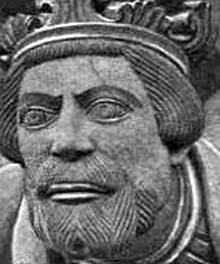Sverre of Norway
| Sverre Sigurdsson | |
|---|---|

Contemporary bust of Sverre from the Nidaros Cathedral, dated c. 1200.
|
|
| King of Norway | |
| Reign | 1184 – 9 March 1202 |
| Coronation | 29 June 1194, Bergen |
| Predecessor | Magnus V |
| Successor | Haakon III |
| Born | c. 1145/1151 |
| Died | 9 March 1202 Bergen, Norway |
| Burial | Old Cathedral, Bergen (destroyed in 1531) |
| Spouse | Margaret of Sweden |
| Issue |
Christina of Norway Sigurd Lavard Haakon III of Norway |
| House | Sverre |
| Father | Unås or Sigurd II of Norway (claimed) |
| Mother | Gunnhild |
| Religion | Roman Catholicism |
Sverre Sigurdsson (Old Norse: Sverrir Sigurðarson) (c. 1145/1151 – 9 March 1202) was the King of Norway from 1184 to 1202. He married Margareta Eriksdotter, the daughter of the Swedish king Eric IX, by whom he had the daughter Kristina Sverresdotter.
Many consider him one of the most important rulers in Norwegian history. He assumed power as the leader of the rebel party known as the Birkebeiner in 1177, during their struggle against King Magnus Erlingsson. After Magnus fell at the Battle of Fimreite in 1184, Sverre ruled as sole king of Norway. Differences with the Church, however, led to his excommunication in 1194. Another civil war began against the church-supported Baglers, which lasted beyond Sverre's death in 1202.
The most important historical source on Sverre’s life is his biography, Sverris saga, in part written while Sverre was alive. This saga is likely biased, since the foreword states that part was written under Sverre’s direct sponsorship. Correspondence between the Pope and the Norwegian bishops can be used as an alternate source when it comes to church affairs. The saga and the letters mostly agree about the hard facts.
Supposedly, King Sverre was short, so he usually directed his troops from horseback during battles. The contrast is great to the traditional Norse warrior ideals where the king was expected to lead his men from the front of the battle line. Sverre was a talented improviser, both in political and military life. His innovative tactics often helped the Birkebeiners against more tradition-bound opponents. During battle he had his men operate in smaller groups, while previously tactics similar to the shield wall had been preferred. This made the Birkebeiners more mobile and adaptable.
...
Wikipedia
